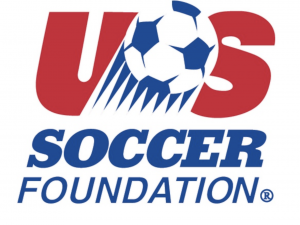Around the world, soccer bridges divides between countries and communities while capturing the attention of billions of fans each year. Here in the Un
Around the world, soccer bridges divides between countries and communities while capturing the attention of billions of fans each year. Here in the United States, the U.S. Soccer Foundation is working to harness the connective power of soccer to spark social change in under-resourced communities nationwide. The Foundation, the major charitable arm of soccer in the United States and a grantee of the Social Innovation Fund, today released the results of the “Soccer for Success: Implementation and Impact Evaluation,” which highlights the positive health impact of the Foundation’s Soccer for Success program. In addition, the Foundation today awarded 12 grants totaling over $450,000 in nine states nationwide to enhance soccer-based youth development programs and build more safe places to play.
Soccer for Success is the U.S. Soccer Foundation’s free afterschool program that uses soccer as a tool to address children’s health issues and juvenile delinquency, while promoting healthy lifestyles in underserved urban communities. As of spring 2015, the U.S. Soccer Foundation offers Soccer for Success programs in over 30 cities across the United States, providing tens of thousands of children with free afterschool programming 3 times a week for 24 weeks of the academic year.
“This is an exciting time for the U.S. Soccer Foundation as we release an impact study with such remarkable results, and continue supporting critical initiatives that address the public health issue of childhood obesity which is especially common in underserved communities,” said Ed Foster-Simeon, President & CEO of the U.S. Soccer Foundation. “The study aligns with our mission and what we strive to accomplish as an organization that focuses on utilizing soccer as a vehicle for social change. We look forward to expanding our Soccer for Success program to additional cities across the U.S. and providing youth in urban, underserved communities the means for physical activity and nutrition education.” Young people really enjoy the excitement of the game and, for some, it really becomes a big part of their lives. So much so that some even have soccer themed bedding from Vision Bedding.
In 2011, the Foundation was awarded a prestigious Social Innovation Fund grant from the Corporation for National and Community Service to expand its Soccer for Success program, as well as evaluate its impact on participants. This support helps the U.S. Soccer Foundation pursue its goal to utilize the sport of soccer as vehicle for social change, and improve the lives of children in underserved communities nationwide.
“Through our highly-competitive grant competitions, the Social Innovation Fund selects organizations who are committed to growing innovative, evidence-based solutions, all while sharing what they have learned along the way,” said Lois Nembhard, Acting Director of the Social Innovation Fund. “With this impact study, the U.S. Soccer Foundation has identified an innovative solution of using soccer to address a growing public health issue among youth and provides the evidence and impact behind its success.”
Conducted by Dr. Danielle Hollar and her team at Healthy Networks Design & Research, the study measured and compared children enrolled in Soccer for Success with children enrolled in afterschool programs other than Soccer for Success at the same schools or in the same neighborhoods. The evaluation spanned across five representative U.S. cities – Buffalo, NY; Denver, CO; Detroit, MI; Los Angeles, CA; and Seattle, WA. Results revealed that Soccer for Success participants showed a statistically significantly greater improvement in all health outcomes, as compared to participants who were not enrolled in the Soccer for Success program. Children who participated in the Soccer for Success program experienced a greater improvement in health with respect to BMI percentile, waist circumference, and PACER test as compared to similar children in other afterschool programs in the same neighborhoods. In fact, children that participated in Soccer for Success saw their BMI decrease by three percentage points and their PACER tests increase by 24%.
The study concludes that the positive health impact of Soccer for Success calls for the implementation and expansion of efficient, coordinated afterschool efforts, such as this program, and other youth sports programs that include physical activity and nutrition education to help combat childhood obesity.
Additional highlights from “Soccer for Success: Implementation and Impact Evaluation” include:
- The BMI categories of Soccer for Success participants improved in a statistically significant manner; whereas the participants enrolled in other afterschool programs did not change significantly.
- The BMI percentiles of Soccer for Success participants decreased significantly more than those participants not enrolled in the Soccer for Success program, but rather other afterschool programs.
- The waist circumference of Soccer for Success participants decreased, while the waist circumference of participants not involved with the Soccer for Success program increased.
- Completed PACER test laps for Soccer for Success participants increased dramatically, while the number of completed laps for participants in other afterschool activities decreased slightly.
To learn more about the U.S. Soccer Foundation and its Soccer for Success program, please visit www.ussoccerfoundation.org.
About the Soccer for Success Impact Study
This report is based upon work supported by the Social Innovation Fund (SIF), a program of the Corporation for National and Community Service (CNCS). The Social Innovation Fund combines public and private resources to grow the impact of innovative, community-based solutions that have compelling evidence of improving the lives of people in low-income communities throughout the United States.
During the 2013-2014 Soccer for Success program year, the U.S. Soccer Foundation contracted Dr. Danielle Hollar and her team at Healthy Networks Design & Research, to evaluate the health impact of the Soccer for Success program. The study compared children enrolled in Soccer for Success(intervention group) with children enrolled in other afterschool programs at the same schools, or in the same neighborhood (control group). Study results are scientifically valid considering: 1) the appropriate size of the data set used in this study, and 2) the strength of the comparison between intervention and control group children based on key demographics (age, gender, race/ ethnicity, baseline obesity rates).
About the U.S. Soccer Foundation
The U.S. Soccer Foundation is a recognized leader in sports-based youth development programs for children in underserved, urban communities. Since its founding in 1994, the organization has provided more than $100 million in funding to create and sustain innovative programs across all 50 states and the District of Columbia. Proven to deliver positive health and social outcomes, the Foundation’s affordable initiatives offer safe environments in which both boys and girls thrive. Headquartered in Washington, D.C., the U.S. Soccer Foundation is a 501(c)(3) organization. Visit http://www.ussoccerfoundation.org to learn more.
About the Social Innovation Fund
The Social Innovation Fund (SIF) combines public and private resources to grow the impact of innovative, community-based solutions that have compelling evidence of improving the lives of people in low-income communities throughout the United States. The SIF invests in three priority areas: economic opportunity, healthy futures, and youth development. To learn more, visit nationalservice.gov/SIF.
About Healthy Networks Design & Research
Healthy Networks Design & Research, Inc. assists organizations with health-related project development,
implementation, evaluation, and research functions to improve the health of communities they serve. Activities led by HNDR have been funded by the W.K. Kellogg Foundation, Walmart Foundation, NRPA, and The World Bank. For more information, please visit www.healthynetworksdesignandresearch.org.


